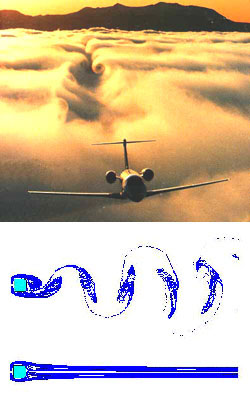Smoothing Out Wake Turbulence

The crash of an airliner in New York in November dramatically demonstrated the problem of wake turbulence. The phenomenon is easy to envision: airplanes and other fast moving vehicles churn the air as they move, leaving behind a tangle of swirls to buffet anything in their wake. Rather than eliminate the turbulence, pilots try to steer clear of it. A report in the 4 February print issue of PRL, however, suggests that a simple countermeasure may help smooth out the air behind any fast-moving object. The authors demonstrate in a computer simulation that a pair of spinning rollers can reduce the air rotation that leads to vortices.
Turbulence develops when an object travels faster than a critical speed determined by the fluid. The resulting vortices show a range of different lengths and durations. Early work on chaotic systems suggested that their sensitivity to tiny changes could be exploited and used to control the chaos. Researchers have shown in computer simulations that simplified, one-dimensional chaotic systems will calm down from a violent state if just the right small forces are applied. But this approach would be impractical in the real world because properties of the system would have to be measured in advance.
Computational scientists Guo Wei Wei and Prasad Patnaik of the National University of Singapore looked for a more realistic way to get the same effect. They reasoned that because the wake vortices contain a lot of rotation, or angular momentum, then perhaps injecting a counteracting momentum into the wake would slow things down. In their PRL paper, they consider a two-dimensional computer model of fluid flowing around a nearly square object. The far side of the object consists of two counter-rotating disks that meet in the middle, like gears, rounding off the object’s trailing corners. With the disks stationary, a typical “vortex street” developed in the wake of the obstruction. But as the team cranked up the disks’ rotation rate, the eddies gradually straightened out, disappearing at a rotational speed just 50% faster than the fluid speed.
Wei explains that the wheels probably reduce the suction that normally forms behind the object and helps generate the vortices. He is still trying to get a better grip on this process, but he predicts the scheme should work well in three spatial dimensions as well. The relatively low speeds involved and the physically simple mechanism should also make it easy to implement a similar system in real aircraft, he says, although he admits that aircraft turbulence forms somewhat differently.
“The idea sounds pretty simple, but it works–that’s the great thing,” says mathematician Ying-Cheng Lai of Arizona State University. No one thought such a simple manipulation could so dramatically control a complex behavior that evolves in space as well as time, he says. Lai notes that the mathematical treatment was as realistic as possible, using the full so-called Navier-Stokes fluid mechanics equation, but he hopes that experimental confirmation will bear the scheme out. “For complex phenomena in spatially extended systems like turbulence,” he concludes, “anything you [could] do would be a major achievement.”
–JR Minkel
JR Minkel is a freelance science writer in New York City.


